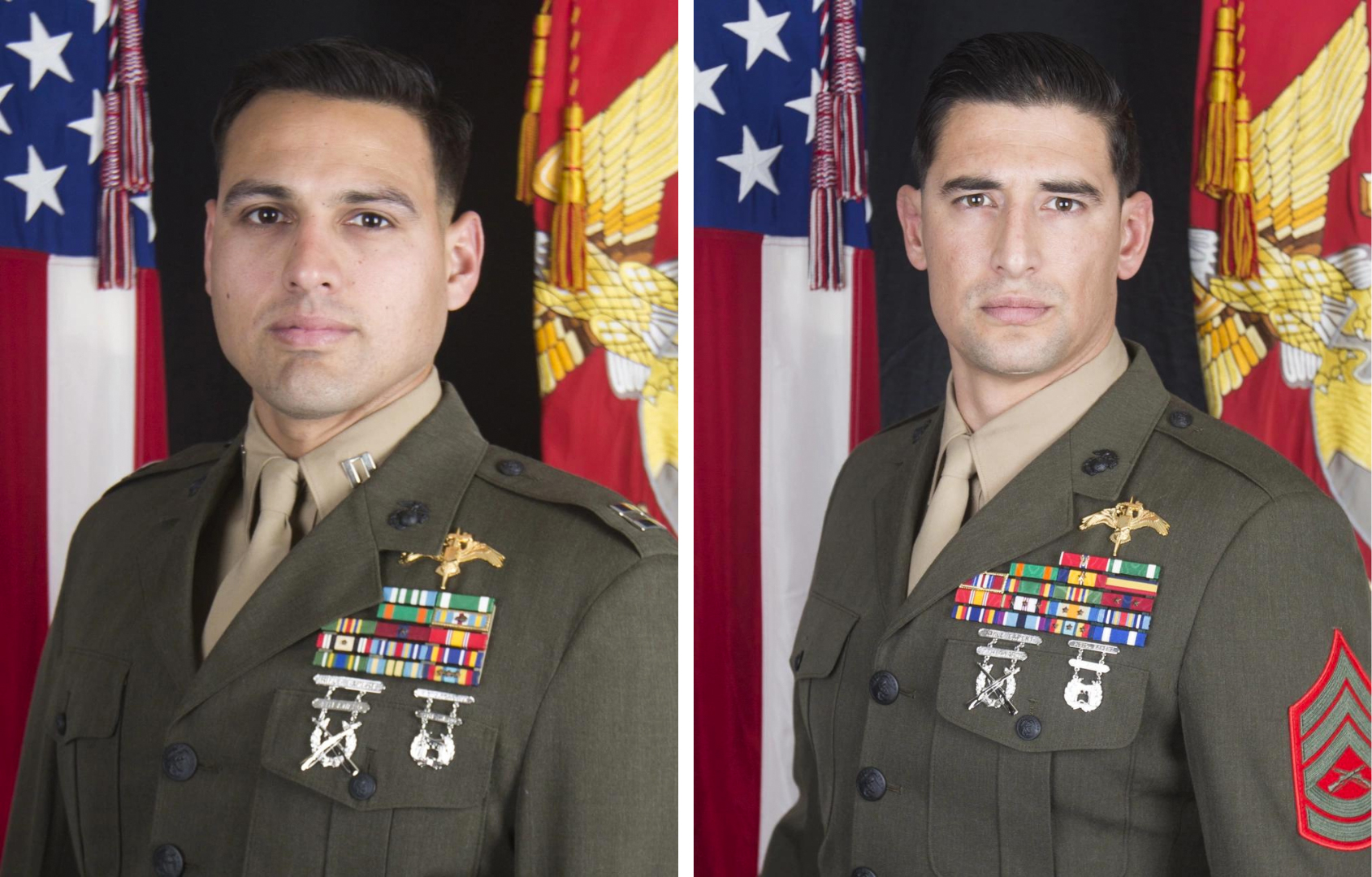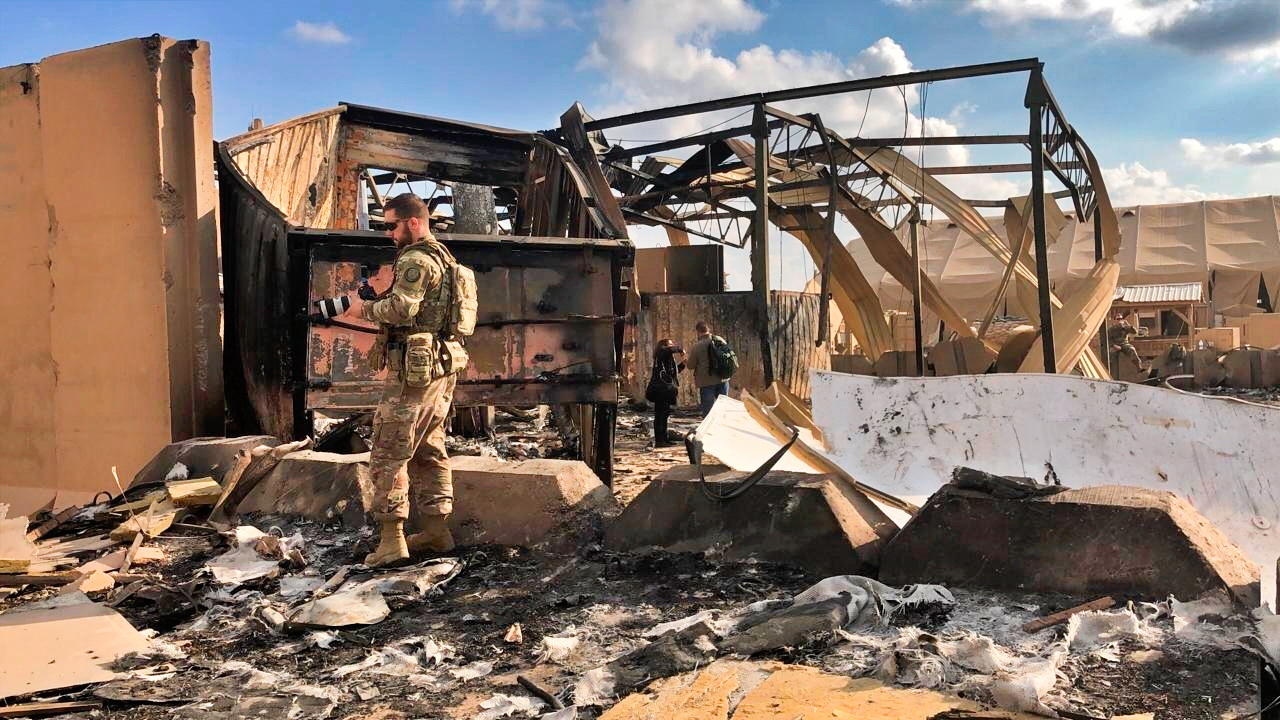The United States government covered up the cause of death of two U.S. military personnel killed in Iranian retaliatory strikes on Ain Al-Asad, a U.S. military base in Western Iraq, in January 2020, following the assassination of Iranian General Qassem Soleimani by the United States, according to claims made to MintPress News by a source close to the family of the deceased soldiers.
On January 3, 2020, then-U.S. President Donald Trump signed off on the ‘targeted assassination’ of General Qassem Soleimani of the Islamic Revolutionary Guard Corps (IRGC) ‘s Quds Force, sparking a round of Iranian retaliatory strikes on bases in Iraq that house U.S. military personnel.
The primary target of the IRGC retaliatory ‘Operation Martyr Soleimani’ was the most significant military base housing U.S. troops in Iraq, the Ain Al-Asad base. Although the extent of the destruction caused by the ballistic missile strikes has been previously outlined by the IRGC using satellite imagery to confirm the impacts caused, Iran has not given an official estimation as to the number of casualties that resulted, nor did they respond to MintPress’ inquiries regarding the matter.
U.S. President Donald Trump delivered a speech on the day of Soleimani’s assassination in which he stated that “Iran appeared to be backing down” and claimed that there were no injuries or fatalities from Iran’s strikes on Al-Asad. This was a far cry from Trump’s previous statements made over Twitter (now X), in which he claimed that the U.S. would respond to an Iranian attack with strikes on 52 sites in Iran, including cultural targets.
Unraveling Discrepancies
Despite Trump’s claim that no casualties had occurred, speculation began to arise following the release of satellite imagery and videos from the scene, which appeared to show massive destruction inside the base. Weeks later, the U.S. military revealed that 11 service members had suffered concussions or traumatic brain injuries (TBI) and were being treated as a result. On January 24, that number jumped to 34, according to the Pentagon.
Nearly a week later, that number changed again. This time, the Pentagon placed the number of TBIs sustained at 50. Days later, it was updated to 64. In February, the statistics were again changed, with the Pentagon revealing that 109 service members had endured TBI’s as a result of Iran’s attack.
On condition of anonymity due to the sensitivity of the matter and out of respect for the victim’s families, a source who intimately knew the two deceased U.S. special operations soldiers in question told MintPress that the pair were killed in Iran’s attack on Ain Al-Asad on January 8 and that the Department of Defense (DoD) intentionally covered up their deaths.
The source claims that Gunnery Sgt. Diego D. Pongo, a critical skills operator, and Capt. Moises A. Navas, a special operations officer, was killed in the attack, but the Department of Defense intentionally mischaracterized their cause of death to the public.
Pongo and Navas reportedly belonged to the ‘2nd Marine Raider Battalion’ and were 34 years old. According to a statement made to MintPress by its source, family members of Pongo and Navas informed him that they were killed while inside a barracks that was struck by Iranian missiles at Ain al-Asad airbase on January 8, 2020.
The families of Pongo and Navas were made to sign Non-Disclosure Agreements, standard practice when special operations soldiers are involved, related to the nature of their deaths, according to MintPress’ source.

According to U.S. Marine Forces Special Operations Command, the pair were killed in combat on March 8, 2020, while ostensibly on a mission fighting ISIS in North-Central Iraq.
MintPress independently reviewed all available statements and news updates released by Amaq and ISIS-affiliated media and found no mention of a conflict with U.S. military personnel at that time, nor was there mention of a clash in which ISIS operatives successfully inflicted casualties on U.S. troops.
On January 9, 2021, Amaq – the official ISIS news agency – published an infographic in which they categorized 1,422 offensive actions that the group committed in Iraq during 2020. In it, meticulous note was made of attacks on the Iraqi army, tribal forces, Kurdish Peshmerga soldiers and militiamen from the Popular Mobilization Units, yet no mention is made of attacks or clashes with U.S. troops.
Amaq has never shied away from claiming credit for attacks, sometimes even attacks it did not commit. The successful elimination of U.S. military personnel, especially elite U.S. special operations soldiers, would be seen as a massive public relations victory for the group.
Covert Conflicts
The U.S. launched Operation Inherent Resolve (OIR) in 2014, losing 17 soldiers in action from 2014 to March 2020, when the deaths of Pongo and Navas were announced, bringing the death toll to 19.
According to U.S. officials at the time, Pongo and Navas were accompanying Iraqi anti-terrorism special forces while attached to the 2nd Marine Raider Battalion’, in an operation against a well-defended cave complex near the town of Makhmur. A report published on the incident by the New York Times stated that no Iraqi counter-terrorism fighters were killed or injured in the clashes despite an hours-long gun battle with ISIS militants. The article goes on to say that the 1st Special Forces Operational Detachment, known more commonly as Delta Force, was among those sent in to retrieve the bodies of fallen Americans.
Reports from Iraqi officials at the time detail weeks of on-and-off clashes with militants from late February into March. A review of those reports indicates that they cannot corroborate details released by the Department of Defense surrounding the official story on the deaths of Pongo and Navas.
It is plausible that U.S. military brass did not provide sufficient detail when reporting the deaths of Pongo and Navas, as is sometimes the case when special operations is involved, but a source with intimate knowledge of U.S. special operations explained to MintPress that the families of special operations fighters are required to sign Non-Disclosure Agreements and said that it is easier to cover up the circumstances surrounding the deaths of special forces fighters.
A Crisis in Credibility
If Pongo and Navas were indeed killed during Iran’s ballistic missile barrage, it would not be the first time the U.S. military has covered up the circumstances of soldiers’ deaths. In 2021, ABC News published an investigative documentary that revealed inconsistencies in the Pentagon’s narrative surrounding a 2017 clash with ISIS fighters in Niger, which resulted in the deaths of four U.S. Green Berets.
Perhaps one of the most infamous incidents, a U.S. military coverup, occurred in 2004 when U.S. Army Ranger Pat Tillman was shot dead by a fellow soldier. When Tillman’s death was initially reported, an elaborate coverup story was produced by the U.S. military in which Tillman had engaged in an epic battle with the Taliban and was ultimately killed by militants.
When it later emerged that Tillman was actually killed in a friendly fire incident, many started questioning the true nature of his death. Tillman was shot in the head three times at close range at a time when no reported enemy fire was occurring. To this day, there have been no conclusive findings in the case. However, some allege that Tillman, who had begun to speak out against the moral stances of his fellow soldiers and military brass, was killed intentionally in a bid to silence him.
Also in 2004, U.S. Marines Rob Zurheide, Brad Shuder, and an Iraqi interpreter were killed in another incident of friendly fire that was covered up for years. After more than a decade, immense pressure from the families of the deceased and a heated congressional hearing, the U.S. military finally admitted that the trio were not killed fighting militants in Iraq’s Fallujah but were killed by an errant 81mm mortar that was fired by fellow American forces.
The following year, in 2005, the Department of Defence (DoD) reported on the death of E3 Private Class LaVena Johnson, announcing she had committed suicide while stationed at the Balad military base in Iraq. At first, the military refused to provide further information, but details later obtained through a Freedom of Information Act request revealed that she was found dead in a burning tent with acid burns on her genitals, a broken nose, black eyes and loose teeth. The official conclusion of the now-closed U.S. Army investigation is that she committed suicide, despite photographic and an autopsy report indicating that her wounds were inconsistent with this finding. A petition remains online calling for the military to reopen the case, and LaVena Johnson’s family conducted their own investigation, which concluded she was beaten, raped and then murdered.
The U.S. military has a long and sordid history of covering up the truth surrounding its soldiers’ deaths, particularly when such incidents are of a sensitive nature. In the case of Iran’s retaliatory strikes against U.S. forces stationed in the Ain al-Assad base, the implications of American fatalities could have meant a wider confrontation between Iran and the U.S. This could explain why the U.S. military refused to admit to any casualties before eventually drip feeding reports of TBI’s to the public weeks later.
Feature photo | U.S. soldiers and journalists inspect the rubble at a site of Iranian bombing, in Ain al-Asad air base, Anbar, Iraq, January 13, 2020. Qassim Abdul-Zahra | AP
Editor’s note: MintPress News could not independently verify the accuracy of the statements from its source for this story. U.S. officials declined to comment on the allegations. Iranian government officials made off-the-record statements to MintPress suggesting that the source’s claims were accurate but did not respond with an on-the-record statement by the time this article was published.
Robert Inlakesh is a political analyst, journalist and documentary filmmaker based in London, UK. He has reported from and lived in the occupied Palestinian territories and hosts the show’ Palestine Files’. Director of ‘Steal of the Century: Trump’s Palestine-Israel Catastrophe.’ Follow him on Twitter @falasteen47


